Mint errors, which occur during the coin manufacturing process, can transform an ordinary dime into a valuable treasure. These errors can make a coin rare and highly sought after by collectors, sometimes turning a dime worth just 10 cents into a fortune. From double strikes to misaligned dies, these mistakes have created some of the most valuable coins in circulation. In this article, we’ll explore how mint errors are turning regular dimes into prized collectibles that can fetch thousands of dollars.
Double Die Obverse Dimes
One of the most famous types of mint errors is the Double Die Obverse error, where the coin’s design is struck twice. This results in noticeable doubling on features like the date or inscriptions. Dimes with this error can be extremely valuable, depending on the extent of the doubling. For example, the 1964 Double Die Obverse Roosevelt dime is highly prized, with well-preserved versions often fetching hundreds or even thousands of dollars.
Clipped Planchet Dimes
A clipped planchet error occurs when the blank metal disc (the planchet) is improperly cut before being struck, causing a portion of the coin to be missing. Clipped planchet dimes are rare and highly collectible, as they stand out with uneven edges and missing sections. These dimes can be worth significantly more than their face value, depending on how much of the coin is missing. Collectors find these errors fascinating because they are both unusual and visually distinctive.
Off-Center Strikes
Off-center strikes occur when the coin is not aligned properly during the minting process, resulting in a design that is stamped partially off the planchet. This error creates dimes with missing details and a misaligned image, making them highly collectible. Off-center strike dimes can range in value from hundreds to thousands of dollars, depending on the severity of the error and the coin’s condition.
Die Cracks and Cuds
Die cracks and cuds are errors that occur when the minting dies themselves are damaged. A die crack is a visible crack in the die that creates a raised line on the coin’s surface, while a cud occurs when part of the die breaks off, creating a raised lump or defect on the coin. Both die cracks and cuds are common in error coins, and depending on the size and visibility, dimes with these errors can be worth far more than their face value.
Mint errors can significantly increase the value of an otherwise ordinary dime. Whether it’s a double die obverse, clipped planchet, off-center strike, or a die crack, these errors can turn a regular coin into a rare and highly prized collectible. If you find a dime with any of these characteristics, you could be sitting on a small fortune!
FAQ’s:
1. What is a double die obverse dime?
It’s a mint error where the design is struck twice, creating a doubled appearance on features like the date or inscriptions.
2. What causes a clipped planchet error?
This error happens when the blank metal disc (planchet) is incorrectly cut, leaving part of the coin missing.
3. How do off-center strikes occur?
Off-center strikes happen when the coin is misaligned during the minting process, causing the design to be partially off the planchet.
4. Are die cracks and cuds valuable?
Yes, depending on the size and visibility of the crack or cud, these errors can make a dime more valuable to collectors.
5. Where can I sell mint error dimes?
You can sell mint error dimes through online auction sites, reputable coin dealers, or at coin shows.













